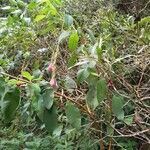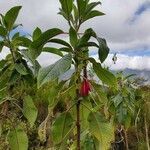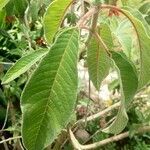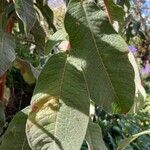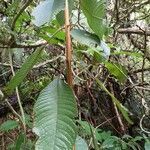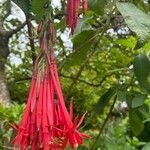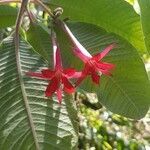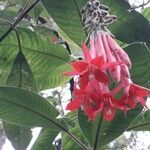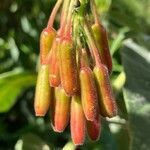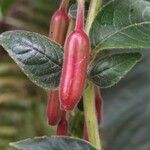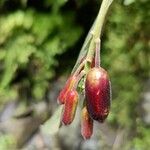Densely hairy or tomentose, evergreen shrub to 3 m high, with long thin stems bearing lvs towards apex; shoots green. Lvs opposite; petiole to 8 cm long, reddish pink, rather stout. Lamina to c. 20-(25) × 9-(10) cm, often smaller below infl., elliptic, with appressed hairs, remotely denticulate with teeth hidden amongst marginal hairs; base cuneate to rounded; apex acute or short-acuminate. Infl. terminal, pendulous, corymbose, becoming racemose at fruiting. Fls subtended by leafy bracts, these smaller towards the apex. Pedicels 5-20 mm long, slender. Floral tube 5-6 cm long, gradually widening upwards, pink or crimson, hairy inside and outside. Sepals 1.5-2.2 cm × c. 4 mm, lanceolate, pink or crimson, acuminate, reflexing at anthesis, with scattered hairs outside. Petals 1.2-1.5 cm long, elliptic-oblong, crimson, imbricate. Stamens c. 10 mm long, subequal, crimson. Style 1-1.5 cm long, exserted part glabrous, otherwise densely hairy; stigma 4-lobed. Fr. c. 2 cm long, oblong, shining black, puberulent.
More
An erect shrub or small tree. It grows to 3.5 m high. The leaves are soft and grey green. Sometimes the veins are reddish. They grow in rings of three. They are narrowly oval or egg shaped. They have a pointed tip and there are teeth along the edge. The flowers hang down and occur in clusters as long scarlet tubes. The fruit is edible.
With more or less pubescent or puberulous stems and leaves, drooping red flowers whose hypanthium is 3–6 cm. long, and sepals 1–2 cm. long, is cultivated in Tanganyika, Njombe District, Aug. 1936, C. J. McGregor 14!
Easily distinguished from the following species by its drooping inflorescences of bright red flowers with a floral tube 5-6 (instead of less than 1) cm long.
Can be grown by cuttings or seedlings. Seeds needs soaking.
